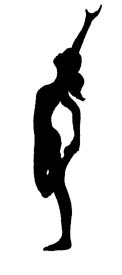Assess Flexibility
 Learn how to assess flexibility before you start an exercise program. Flexibility is defined as the range of motion possible around a joint. Like muscle strength and endurance, flexibility level is specific to each joint and its surrounding muscles. There is no single test that assesses total body flexibility. Flexibility assessment is important when range of motion is limited around a joint due to muscular tightness, that joint is more susceptible to injury. This is especially evident for proper functioning of the spine; tight erector spinae, hamstring, and iliopsoas muscles have all been implicated as possible causes of lower back pain.
Learn how to assess flexibility before you start an exercise program. Flexibility is defined as the range of motion possible around a joint. Like muscle strength and endurance, flexibility level is specific to each joint and its surrounding muscles. There is no single test that assesses total body flexibility. Flexibility assessment is important when range of motion is limited around a joint due to muscular tightness, that joint is more susceptible to injury. This is especially evident for proper functioning of the spine; tight erector spinae, hamstring, and iliopsoas muscles have all been implicated as possible causes of lower back pain.
The ability to comfortably perform activities of daily living (such as bending over and picking up a piece of paper is limited if the only is inflexible.
Flexibility is assessed directly by goniometers, inclinometer and flexometers. These tools actually measure the individual joint angle in degrees as the boy part is moved through its range of motion.
Goniometer test
The gonionmeter is a protractor-like device with two steel or plastic arms that measure the joint angle at the extremes of the ROM. To use the goniometer, place the center of the instrument so it coincides with the fulcrum, or axis of rotation, of the joint. Align the arms of the goniometer with bony landmarks along the longitudinal axis of each moving body segment. Measure the Rom as the difference between the joint angles (degrees) at the extremes of the movement.
Flexometer Test procedure
This device consists of a weighted 360 degree dial and weighted pointer. The ROM is measured in relation to the downward pull of gravity on the dial and pointer.
To use this device, strap the instrument to the body segment, and lock the dial at 0 degrees at one extreme of the ROM. After the client executed the movement, lock the pointer at the other extreme of the ROM. The degreeof arc through which the movement takes place is read directly from the dial. Test have been devised to measure the ROM at the neck, trunk, shoulder, elbow, radioulnar, wrist, hip, knee, and ankle joints using the Leighton flexometer.
Inclinometer Test
The inclinometer is another type of gravity-dependent goniometer.
To use this device, hold it on the distal end of the body segment. The inclinometer measures the angle between the long axis of the moving segment and the line of gravity.
Here are some general guidelines for flexibility testing for measuring static flexibility
Have the client perform a general war-up followed by static stretching prior to the test and avoid fast, jerky movements and stretching beyond the pain-free range of joint motion;
Administer three trails of each test item;
Compare the client’s best score to norms in order to obtain a flexibility rating for each test item; and Use the test results to identify joints and muscle groups in need of improvement.

